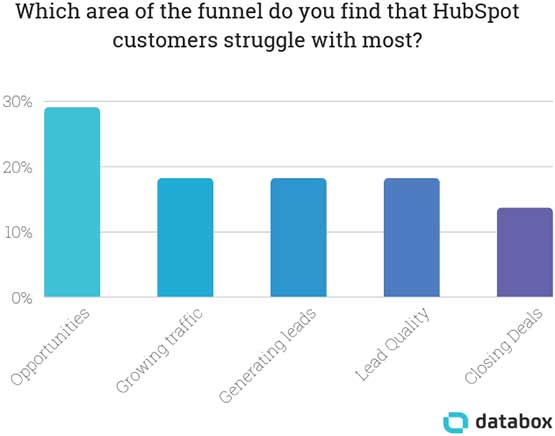Using HubSpot can help your company (or your clients) build a content marketing foundation. When done right, it can help you grow your audience, capture more leads and convert those leads into sales. But some simple mistakes can derail those efforts. We teamed up with the research team at Databox and asked 38 marketers which content marketing mistakes they’ve seen HubSpot users make most often.
While the most common struggle companies have is turning leads into opportunities, customers struggle with every part of the inbound marketing and sales process.

Here’s what they had to say about specific content marketing mistakes:
Lack of Strategy
“The biggest inbound marketing mistake HubSpot users make,” says Abdul Aziz from Arcs & Curves, “is lack of a well-defined, keyword-researched content strategy.”
“A lot of companies that use HubSpot and rely on inbound marketing to generate leads have gotten the fundamentals wrong. They're under the delusion that by publishing tons of blogs, their website traffic will drastically increase and convert visitors into leads.”
“By not having a keyword-researched and buyer's-journey-guided content strategy, many companies are missing the opportunity to generate high-quality leads.”
“If there's no strategy, there's no direction. And if there's no direction, well then, the website won't attract the attention of the right prospects.”
HubSpot users, says Aziz, “should make use of features such as the content strategy tool, built-in SEO optimization tools, custom lead flows, calls-to-action, and website analytics.”
“Once the website content is backed by a well-defined, SEO-optimized strategy, HubSpot users can start seeing benefits.”
Not Setting Strategic Goals
Steven Kurniawan from Nine Peaks Media told us about “one common (and somewhat fatal) mistake in content/inbound marketing.”
This common marketing mistake, says Kurniawan, is “not properly defining the goal(s) of the content marketing activity, which makes it impossible to define the proper KPIs and measure the right metrics.”
“In short, companies just publish content blindly without any purpose.”
“Will your content help you acquire more prospects? If so, how many new prospects are your target? Will your content help you educate customers until they are ready for a purchase? If so, what kind of increase in conversion rate are you expecting?”
Stan Tan from Selby’s points out another top content marketing mistake:
The #1 mistake I see businesses make is writing content that doesn’t directly or indirectly generate sales for the business. For example, writing articles that target keywords with the highest searches regardless of the relevance to the business.
 Stan Tan Digital Marketing Specialist, Selby
Stan Tan Digital Marketing Specialist, Selby Tan gave us a scathing example of this marketing error in the real world: “HubSpot, the king of inbound marketing writing a post about how to make a gif.”
“Do you think teaching someone to make a gif will result in more leads and trials to their CRM and marketing automation system? Maybe 1 out of 10,000 people reading that article will be the right client but nothing that will generate a significant business result for Hubspot.”
He continued, “Of course, HubSpot with their multi-million dollar marketing budget can do this and it helps them attract links and improve their domain authority. But, if you’re working with a more modest budget, creating content that converts is a better investment.”
Not Taking a Full-Funnel Approach
“The content mistake I see most often being made by HubSpot users,” says Spitfire Inbound’s Alison Leishman, “is not facilitating the buyers journey to its full potential when planning, creating, formatting, and distributing content—which usually results in not harnessing the full power of the HubSpot tool.”
“The ability to use Smart CTAs and content is not utilised and every visitor gets the same experience. Ideally, content should entice people to want to explore further, or better yet, to engage. It is up to you to give them the opportunity for them to do this.”
“And by having a robust strategy based on the buyers journey you will ensure that not only do you provide them this opportunity, but you also provide a choice of platforms to do this in—social media, chat, lead flows, email or on your site.”
Gray Group’s Tiago Santana agrees:
Traditional marketing has often been so focused on the point of sale, or as we inbound folk like to call it ‘decision stage.’ When business owners are starting with inbound marketing, they have trouble focusing on anything but sales-related content.
 Tiago Santana Founder and CEO, Gray Group
Tiago Santana Founder and CEO, Gray Group “As business owners begin to understand the importance of awareness, consideration, and decision stages they often do not want to accept that it can often be a process.”
“But, by really taking time to examine each step of the process, we can create content that is better for prospects when they first hear about a company, content for newer customers, content that suits customers that have been loyal for years, and content that helps them tell all their friends about you.”
“Then it begins to get fun,” says Santana.
Forgetting About Promotion
Some of JijOnline’s clients are “new to the game” and “think that just blogging and creating valuable content is enough,” says Sebastian Kopp.
“They forget about the distribution side of things. You can have the most awesome content ever. But, if no one is consuming it, what’s the point?”
Rick Kranz from OverGo Studio also emphasizes the importance of distribution in content strategy:
“The most common mistake we see HubSpot users making when it comes to content marketing is not putting any thought or time into promoting the great blog post that they just wrote.
“Just because you wrote a great piece of content doesn't mean that anyone is going to find it or that Google will list you on the first page of their serp results.”
“The biggest mistake marketers are making today,” says Omi Diaz-Cooper from Diaz & Cooper, “is doing the old ‘write 4 blogs a month’ tactic and assuming that it will attract a significant volume of traffic and leads.”
It just doesn’t work that way anymore.
Not Having Clearly Defined Personas
An effective content strategy is built on clearly defined buyer personas.
“If you don't know who your audience is or the specific problems they face,” asks Kim Keate from Whittington Consulting, “how can you effectively communicate with them? How can you make sure you are meeting their needs?”
“Do you know their gender, age range, or job titles? Do you know what questions they are asking or what their hesitations might be for what you are selling? How do they prefer to digest information? Would they rather watch a video or read a blog article?”
“It's easy to get caught up in business objectives or needs but if you're not creating content with your target audience in mind it's like throwing darts against a wall hoping one of them will stick. You'll be wasting valuable time and resources and will have poor results to show from it.”
Kolby Kloosterman from HA Digital Marketing lays it out like this:
“When you create content and blogs specifically for this ideal buyer, you are more likely to engage real people who fit the buyer persona profile.”
“The mistake we see here is that new users do not take the time to fully research and develop this semi-fictional persona and therefore do not have a clear direction or audience when it comes time to create compelling content.”
Related: What are Buyer Personas and How to Use Them
Not Diving Deep Enough
Saša from Issimo Fit points out that developing one surface-level persona isn’t enough:
“Example: an exporting company has actually multiple buyer personas, but they believed that a high-level description of one persona was enough. It didn’t work.”
Dropkick Copy’s Nabeel Azeez has a simple solution for problems like this:
Without a doubt, the #1 inbound marketing mistake Hubspot users make is not TALKING to their best (or ideal) customers when defining their content strategy.
 Nabeel Azeez Founder, Dropkick Copy
Nabeel Azeez Founder, Dropkick Copy “This means they rely on guesswork to come up with topics.”
“Keyword research isn't enough either. Chasing SERPs gets you traffic. But there's no guarantee that traffic is high quality.”
Letting Personas Get Stale
“One mistake that I see HubSpot users make,” says Campaign Creators’ Shelby Heath, “is not having personas or not having updated personas.”
“All content on an website should be geared towards the buyer personas—which is a little difficult to do if you don’t have one or it is out-of-date.”
“Personas can also change over time and as your company grows, so it is important to re-evaluate your personas every year and make sure they are still your target audience, and if not—change them!”
Too Much Focus on the Tool
Rakshit Panchal from Gurukrupa Printwell says “When some companies use a marketing automation tool like HubSpot, they are often unconsciously too dependent on that tool, rather than facts of the marketing situation.”
HQdigital’s Meghan Hultquist agrees: ‘The technology alone will not be sufficient to get you the results you want.”
“HubSpot and other marketing platforms are powerful tools, but they aren't going to do the actual work for you,” adds Erik Norsted from Olive & Company. “The tools aren't going to conduct your research, create your content, or rethink a lead nurturing campaign.”
The tools will help streamline the management of these things and provide insights to steer your program, but, if you want to see real results from your inbound marketing, be prepared to work.
 Erik Norsted Chief Strategy Officer, Olive & Company
Erik Norsted Chief Strategy Officer, Olive & Company “This is especially true with content. In order to cut through the noise as more and more companies are creating more and more content, inbound marketers need to evolve beyond the thin blog content of the past and focus instead on creating authoritative content experiences in a variety of formats.”
Not Fully Utilizing Features
On the other end of the spectrum are HubSpot users that aren’t using HubSpot to its full potential.
“The most common mistake is not taking advantage of all the tools that HubSpot offers,” says Mario Merino Fernandez from El Orfanato Ideas Sin Madre.
Matt Jacoby of Octave Media agrees about this content marketing mistake:
“[T]he one mistake I see HubSpot users make the most often is not using the tool strategically.”
“Niche or non-niche, they spend all this money on the platform and use it for just one or two of the tools, usually email and the blog, not really realizing they aren't getting anywhere near the full value of their investment.”
“It seems by the time I come into the mix, they've made a mess in areas like workflows or landing pages and we need to review what was done, how it could be done better. We can usually find ways to show quick value before doing a U-turn and working on a plan to attempt executing on a larger, more long-term fix/solution.”
“I also feel most of them aren't even aware of certain things, like a lot of them don't even know that HubSpot has a social media tool!”
And while most of them do use the blogging tools, they don't understand the value of placing a call to action on every article to help establish additional lead conversion points.
 Matt Jacoby Chief Percussion Officer, Octave Media
Matt Jacoby Chief Percussion Officer, Octave Media Hello Anna’s AnnaLea Crowe adds segmentation to the list of features that don’t get used often enough.
Related: Hire one of our HubSpot Certified Experts
Not Taking Advantage of Assets
“Users often forget to do the little things when it comes to setting up their campaigns in HubSpot,” says Campaign Creators’ Jesse Schor.
“Tying assets together in HubSpot by a single "Campaign" is so beneficial when it comes to internal organization and managing closed-loop reporting.”
Kara Susvilla adds that users should also share marketing assets across different social platforms. “HubSpot users can often assume if their marketing content is not receiving traction, there must be an issue with the content. It's important to test content on different platforms because it may not always be the content's issue, but rather the platform.”
Bad Content
One of the biggest content marketing mistakes that people make—regardless of the platform they use—is publishing bad content.
And we found out all sorts of ways that HubSpot users are making that content marketing mistake:
- Not focusing on SEO (Zach, DePalma Studios)
- Relying too much on gated content (Shreyansh Surana, Fractional CMO)
- Not creating a strategic content calendar (Shaye Smith, The Center for Sales Strategy and LeadG2)
- Lifeless landing pages (Nate Masterson, Maple Holistics)
- Hiring writers on the cheap and getting plagiarized material (Brad Smith, Codeless)
- Paying for low-quality content (Don Arceri, Aspire)
Related: 5 Simple Steps to a Better Content Development Process
Content for the Sake of Content
“The biggest mistake we see is the rapid creation of content for the sake of creating more content,” says Tim Jones from Eternal Works.
“Often times people think that it's just about creating more blogs, more videos, more eBooks.”
“Then they wonder why they are not attracting visitors or converting visitors to leads. Ultimately, it's because no one is looking for a company that creates the most content.”
“They are looking for a company that provides the most value and helps them solve their problems and reach their goals.”
Ideagency’s Burdet sees the same issue regularly:
“Many businesses think that more content leads to more traffic, more leads… and more customers! But that’s not the way it works and that’s not as easy as it sounds. The main priority should definitely be on the quality of your content.”
“Many studies (ex: Hubspot, Moz) showed that more blog posts led to higher inbound traffic but they didn’t take into consideration the « quality » of the content.”
“Some studies also showed that the minority of content attracts a lot of links and shares. Sometimes, it’s better to produce 1 long-form content of high quality rather than producing 5 short-form of poor quality.”
HubSpot itself can be used an example, says Burdet: “[B]y using the Pillar-Cluster Model to transform their blog, Hubspot reduced the number of blog posts. As a result, they started to see improvements in search rankings, they increased their website traffic and generated more qualified leads.”
Always Selling
“The biggest mistake and most common mistake for inbound marketers is trying to sell their product in every aspect of their business,” says Matt from Apruve.
They use blogs to point to the benefits of their products which makes their content unshareable.
 Matt Osborn Director of Marketing, Apruve
Matt Osborn Director of Marketing, Apruve “The focus should be to have neutral content that drives thought leadership, and creating unique Call-to-actions around each topic discussed. Then trusting your nurture campaigns to drive curiosity in your product.”
This was a common refrain:
- “My biggest pet peeve? Selling, selling, selling...and selling in your blog and other content.” (Tommy Landry, Return On Now)
- “So many companies still talk about themselves way too much in their content, making it sound overly salesy. Prospects don't care about your business, they care about their problems and are looking for solutions.” (Kelly Wilhelme, Weidert Group)
- “Many blog about their products and services (themselves), an opinion post or even worse a current popular topic (just because it is getting a lot of public attention). Nothing they publish addresses their buyers needs.” (Lauren Canning, Hello Marketing Agency)
Similarly, many companies write only for bottom-of-funnel readers, says Avidly’s Jonas Faizi.
“60–70% of the customer's buying process and research is completed before they start talking to you about a possible deal. That means you are [losing] out on an opportunity to influence the buyer at an earlier stage and help them find the best solution for their challenge.”
No matter which platform you use, that’s just not the way to approach content marketing.
Related: Sell Without Selling - The Secret to a Great Guest Post
Bad Calls to Action (CTAs)
“One of the most common content marketing mistakes I see HubSpot customers make is not providing CTAs in their blog content,” says Nathan Heider from Campaign Creators.
“If you don't provide clear direction to the next piece of content they should read or action they should take, leads will simply leave your blog because they don't know where to go.”
Related: Mastering the Art of the Flawless Call to Action
The Wrong CTA for the Buyer Stage
So often, I see websites only promoting decision-stage calls-to-action on their website. “[E]ven alongside awareness and consideration-stage content.
 Jennifer Lux VP of Client Experience, LyntonWeb
Jennifer Lux VP of Client Experience, LyntonWeb “This creates a disconnect in the user experience and doesn't support the foundation of Inbound Marketing, which is meeting your audience where they are at in the buyer's journey and nurturing them into decision-stage steps.”
“This misalignment results in companies even appearing desperate to get visitors to a demo before they have completed necessary steps like educating, building trust, and providing social proof.”
Derrick Weiss from SkuNexus gives similar advice:
“Asking visitors to 'subscribe to the blog' without providing a good reason to do so. HubSpot has a few, very easy, built-in ways of adding a form for blog subscriptions—and many will take the easy path of saying the purpose of the form, and won't talk about the underlying value that their content provides on a regular basis.”
“And with all the hullabaloo around GDPR recently, these forms also tend to have a large amount of dry, unexciting text that is quickly becoming ubiquitous. It's nice to know what's going to happen to my email address, but why should I give it to you?”
HubSpot Can Help—If You Use It Correctly
Using the right tool for your content marketing can help you reap the benefits of inbound. But it’s easy to use it incorrectly.
Whether you focus too much on the tool, don’t use its features to their full extent, or just don’t have the strategy and content to run a good content operation, you’re not going to meet your marketing potential.
Learn from the experiences of other marketers, fix your (and your clients’) HubSpot content marketing mistakes, and you’ll see big improvements in your content marketing.
To learn more about marketing strategies to avoid and how to do content marketing right, check out our white paper, "How the Right Blog Content Strategy Can Power and Simplify All Your Online Marketing."
What are some of the worst content marketing mistakes have you seen HubSpot users make? How do you go about fixing them? Share your thoughts in the comments below!

About the author - Dann Albright
Dann is a freelance writer who helps B2B companies reach their audiences more effectively. With an emphasis on organic traffic and conversion, he takes big ideas and turns them into highly practical content that keeps readers hooked.













